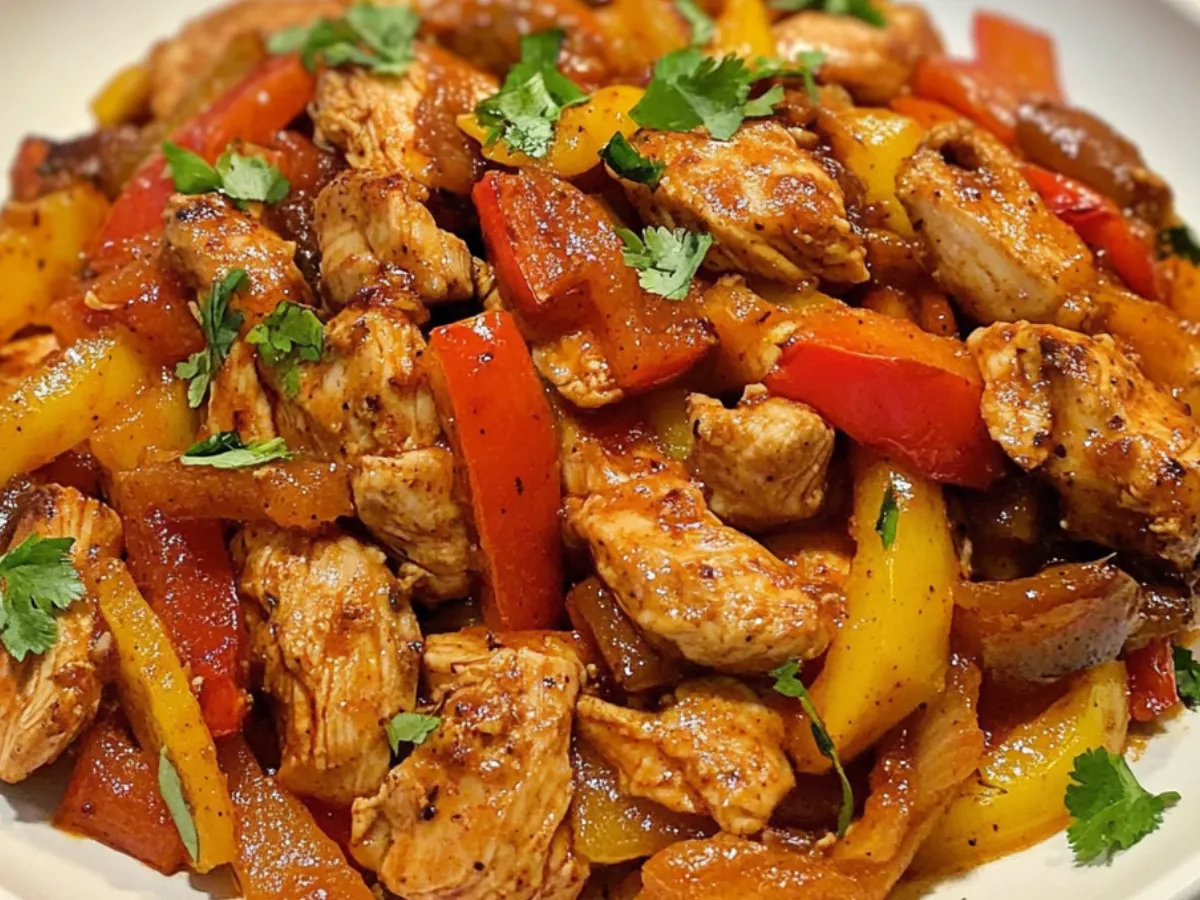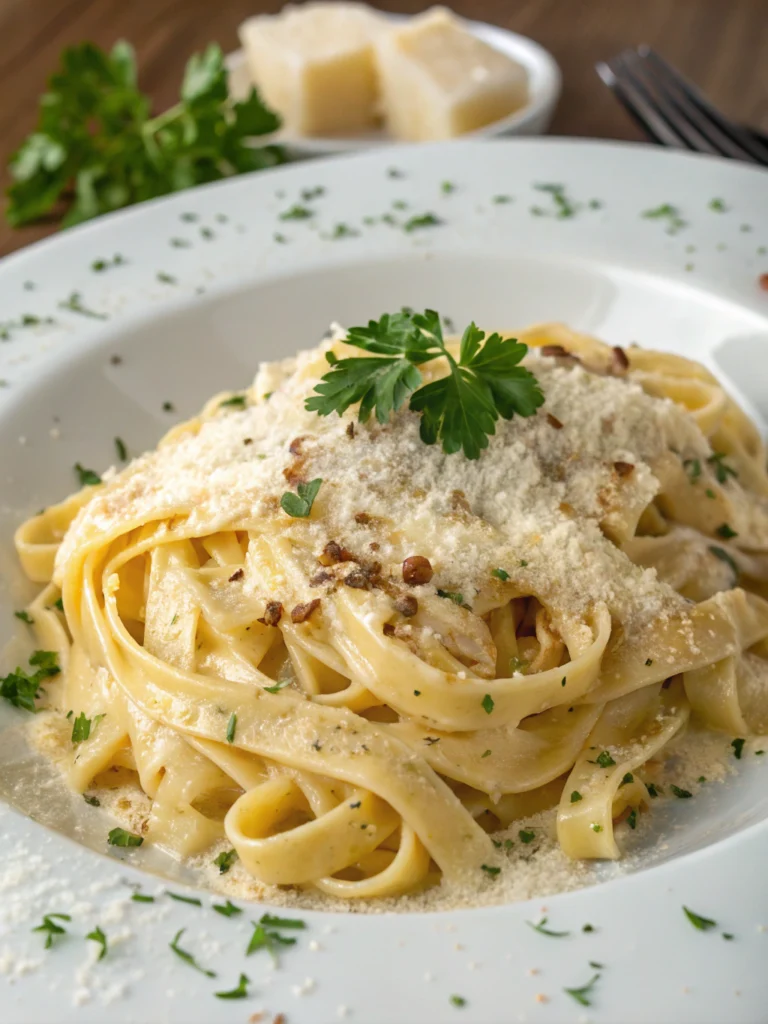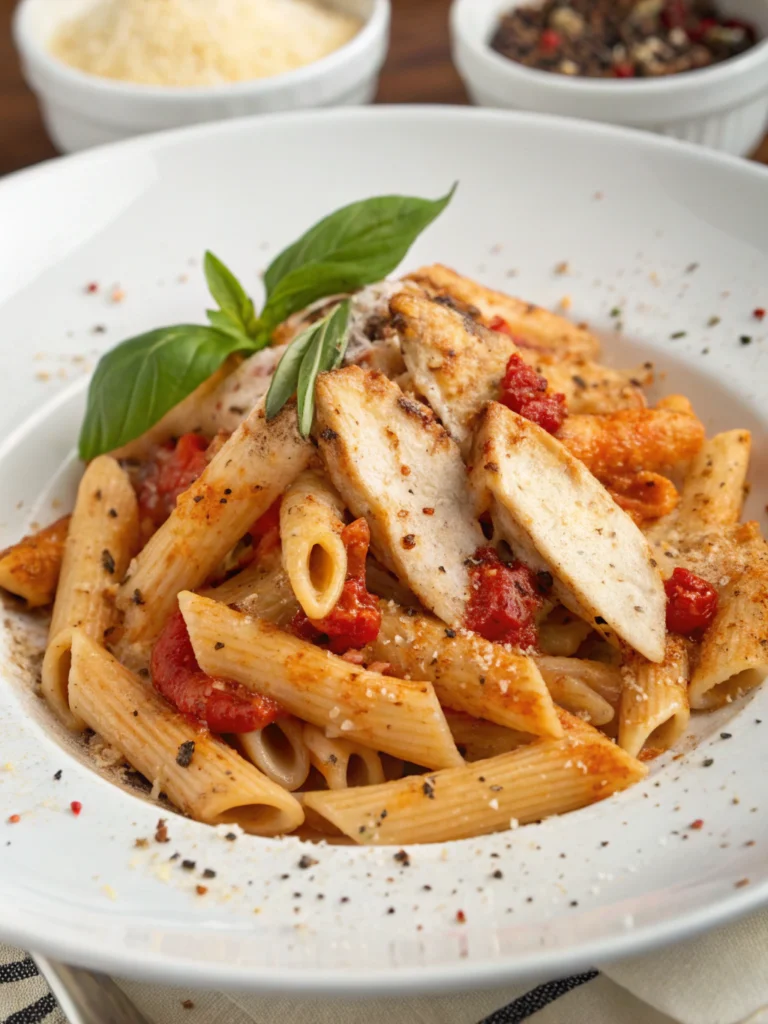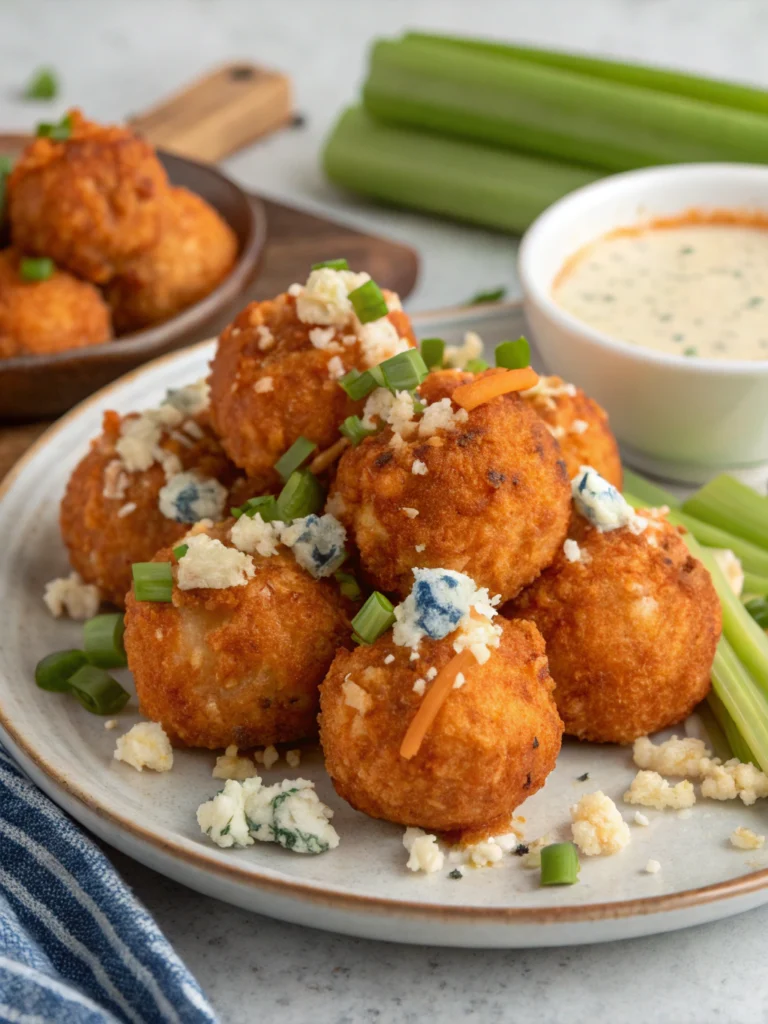There’s something special about a sizzling chicken fajita dish that instantly transports me to a vibrant Mexican evening. The combination of juicy chicken breasts, colorful bell peppers, and onions, all perfectly seasoned and cooked in a hot pan, is truly irresistible.
As someone who loves cooking quick and delicious meals, I’ve found that fajitas are a staple in my kitchen. This recipe is not only easy to follow but also packed with flavor, thanks to the perfect blend of homemade seasoning and a squeeze of fresh lime juice.
Key Takeaways
- Quick and easy chicken fajita recipe perfect for weeknight dinners.
- Restaurant-quality fajitas made at home with minimal effort.
- Delicious combination of chicken, bell peppers, and onions.
- Homemade seasoning blend adds extra flavor.
- Ready in under 30 minutes, ideal for busy evenings.
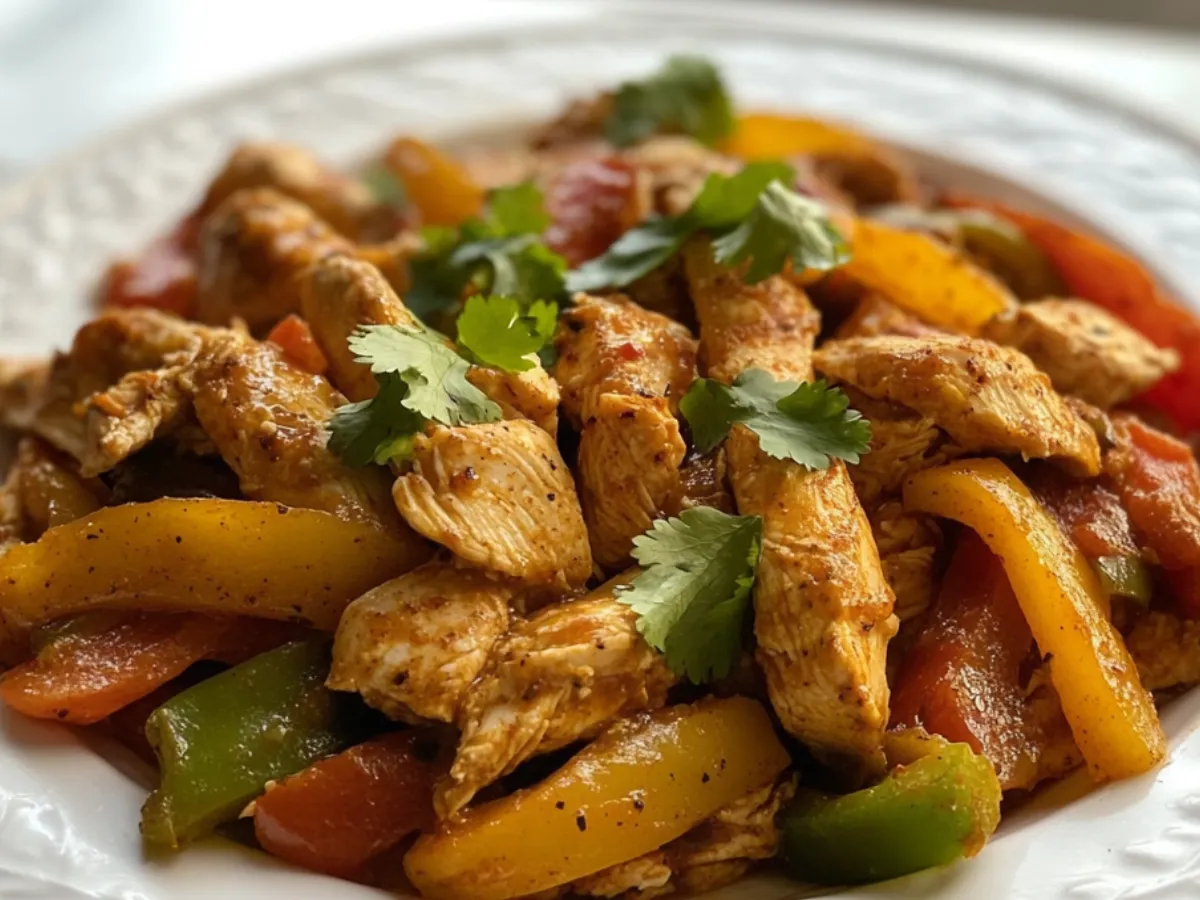
Why I Love This Chicken Fajita Recipe
My chicken fajita recipe has become a staple in my kitchen, and for good reason. It’s a dish that’s both quick to prepare and packed with flavor. This chicken fajita recipe is a perfect blend of time-saving and delicious.
My History with Fajitas
Fajitas have been a favorite of mine for years, and I’ve spent a lot of time perfecting my recipe. I’ve experimented with different ingredients and techniques, but I’ve finally landed on a method that yields consistently great results.
What Makes This Recipe Special
So, what sets my chicken fajita recipe apart from others? For starters, the homemade fajita seasoning is a game-changer. By making my own seasoning blend, I can avoid preservatives and excess sodium found in store-bought packets.
- The recipe is versatile and allows for easy customization based on personal preferences and available ingredients.
- Cooking the chicken and vegetables separately ensures each component is perfectly cooked, resulting in great flavor.
What You’ll Need for Perfect Chicken Fajitas
To make perfect chicken fajitas, you’ll need a few essential ingredients and some basic kitchen equipment. The right tools and ingredients can make all the difference in achieving that authentic fajita flavor and texture.
Protein and Vegetables
For this recipe, you’ll need chicken breast or thighs, sliced into thin strips. I prefer using chicken breast for its leaner profile. You’ll also need bell peppers and onions, sliced into uniform strips to ensure even cooking. The quality of your protein and vegetables directly impacts the overall taste and texture of your fajitas.
Homemade Fajita Seasoning Ingredients
Creating your own fajita seasoning blend is simple and allows you to customize the flavor. You’ll need a mix of spices including chili powder, cumin, paprika, garlic powder, and oregano. Combining these spices gives your fajitas that authentic flavor. When you heat the spices, they release their full aroma, enhancing the dish.
Kitchen Equipment
A large cast iron skillet or heavy-bottomed pan is ideal for cooking your fajitas over high heat. If you don’t have a cast iron pan, a stainless steel pan will work. You’ll also need a sharp chef’s knife for slicing your chicken and vegetables. Having the right pan and knife makes a significant difference in preparation and cooking time. To prevent sticking, add a small amount of oil to the pan before cooking.
Preparing Your Homemade Fajita Seasoning
Creating your own fajita seasoning is a simple yet impactful step in making exceptional chicken fajitas. By mixing your own blend, you can avoid additives and preservatives found in store-bought options.
The Perfect Spice Blend
A well-crafted fajita seasoning blend is all about balance. It combines spices like chili powder, cumin, and paprika with a touch of cayenne for heat. The beauty of making your own seasoning lies in its customizability; you can adjust the levels of salt, heat, and other flavors to suit your taste preferences.
Store-Bought vs. Homemade Comparison
While store-bought fajita seasoning is convenient, homemade seasoning offers several advantages. Here are a few key differences:
- Store-bought seasonings often contain unnecessary additives like anti-caking agents and preservatives.
- Homemade seasoning allows you to tailor the flavor to your liking, adjusting for heat, salt, and other preferences.
- Making your own seasoning is cost-effective, especially if you already have a stocked spice cabinet.
By investing just a few minutes to mix your own fajita seasoning, you’ll enhance the flavor of your chicken and vegetables, elevating your entire dish.
Prepping Your Chicken and Vegetables
Preparing the chicken and vegetables is a crucial step in making delicious fajitas. This step ensures that your dish is not only flavorful but also visually appealing.
Slicing Techniques for Chicken
To slice the chicken effectively, it’s essential to cut it against the grain. This technique makes the chicken more tender and easier to chew. Cutting into thin strips, about 1/4 inch thick, is ideal for fajitas. You can use kitchen shears or a sharp knife for this task.
How to Cut Peppers and Onions for Fajitas
For peppers and onions, slice them into thin strips as well. This helps them cook evenly and quickly. You can cut the peppers into any color you prefer, and it’s a good idea to use a mix for a vibrant look. Onions can be sliced into rings or strips, depending on your preference.
Time-Saving Prep Tips
To save time, consider prepping your ingredients ahead. You can marinate the chicken for up to 4 hours before cooking. Additionally, slicing the vegetables the night before or in the morning can make the cooking process smoother. Using pre-sliced peppers and onions from the store is another option for a quick recipe.
By following these tips, you’ll be able to enjoy a delicious and stress-free fajita night.
My Chicken Fajita Recipe: Step-by-Step Instructions
Now that we have prepped our ingredients, let’s dive into the step-by-step instructions for making delicious chicken fajitas. This process involves seasoning the chicken, cooking it to perfection, and sautéing the vegetables to create a flavorful dish.
Seasoning the Chicken
The first step is to season the chicken with our homemade fajita seasoning. I like to coat the chicken evenly, making sure it’s well-seasoned on all sides. This enhances the flavor and aroma of the chicken.
Cooking the Chicken to Perfection
To cook the chicken, I heat a pan over medium-high heat and add a tablespoon of oil. Once the oil is hot, I add the chicken and cook until it’s browned and cooked through. After cooking, I remove the chicken to a plate and let it rest for a couple of minutes.
Sautéing the Vegetables
Next, I add the sliced peppers and onions to the same pan over medium heat. I sauté the peppers onions and other veggies for 4 to 5 minutes, stirring frequently. If the pan seems dry, I add another tablespoon of oil to prevent sticking.
I cook the vegetables over medium-high heat, stirring occasionally, to allow some caramelization to develop. The perfect fajita vegetables should be tender-crisp with some charred edges, which usually takes about 5-7 minutes. Just before the vegetables are done, I season them with a pinch of salt and sometimes add a clove of minced garlic for extra flavor.
By following these steps, you’ll be able to create delicious chicken fajitas with perfectly cooked chicken and vegetables. The key is to cook the ingredients in the same pan, taking advantage of the flavorful bits left behind.
Assembling Your Fajitas
Now that we have our chicken and veggies cooked, it’s time to assemble our delicious chicken fajitas. This final step is crucial in creating a dish that’s not only flavorful but also visually appealing.
Warming Tortillas the Right Way
Warming tortillas is essential for making great fajitas. To do this, simply wrap a damp paper towel around your flour tortillas and microwave for 20-30 seconds. This will make them more pliable and easier to fold.
Building the Perfect Fajita
To build the perfect fajita, start with a warm tortilla as the foundation. I typically use 6-inch flour tortillas which are the perfect size for handheld fajitas. Here’s how I assemble mine:
- Begin by adding a modest portion of chicken (about 2-3 strips) down the center of the tortilla, being careful not to overfill.
- Next, layer on the sautéed peppers and onions, distributing them evenly over the chicken veggies.
- Before folding, add a squeeze of fresh lime juice directly onto the chicken and veggies to brighten the flavors.
- Finally, fold the tortilla by first folding in the sides slightly, then rolling from the bottom up, creating a secure package that holds all the delicious filling.
Delicious Toppings and Sides
Completing your meal with the perfect accompaniments can take your chicken fajitas to the next level. The right toppings and sides not only enhance the flavor but also add texture and variety to your meal.
Essential Toppings
When it comes to chicken fajitas, some toppings are considered essential. A sprinkle of fresh cilantro adds a burst of freshness, while a dollop of sour cream or Greek yogurt can help cool down the spiciness. Shredded cheese, whether it’s cheddar or Monterey Jack, melts beautifully into the warm tortillas.
Optional Add-ons for Extra Flavor
For those looking to add an extra layer of flavor, consider incorporating some recipes like homemade salsa or guacamole. Sweet corn salsa is another favorite that pairs wonderfully with the spicy fajitas. You can also serve your chicken fajitas with a side of homemade tortilla chips and fresh guacamole or queso dip for a complete fiesta.
Side Dishes That Complement Fajitas
When it comes to side dishes, rice is a popular choice. You can opt for Mexican rice or cilantro lime rice to add a flavorful complement to your chicken fajitas. Other great options include black beans or refried beans for additional protein, a simple side salad with a lime vinaigrette, or elote (Mexican street corn) for a sweet and creamy element.
Variations on the Classic Chicken Fajita
While my classic chicken fajita recipe is a staple, there are countless ways to mix it up. Whether you’re looking to change the protein, add different vegetables, or adjust the spice level, I’ve got you covered.
Protein Substitutions
If you want to try something different, you can substitute the chicken with other proteins. Shrimp and steak are popular alternatives that work well with the fajita seasoning. For a vegetarian option, consider using portobello mushrooms or tofu. Simply adjust the cooking time based on the protein you choose.
Vegetable Variations
You can also mix up the vegetables in your fajitas. While bell peppers and onions are classics, you can add other vegetables like zucchini, carrots, or tomatoes to create a different flavor profile. Simply sauté them along with the onions and bell peppers.
Spice Level Adjustments
Even though the chicken fajitas are well seasoned, they are pretty mild in spiciness. If you prefer spicier fajitas, you can add more chili powder to taste. Other options include increasing the cayenne pepper in the fajita seasoning or adding a pinch of crushed red pepper flakes. You can also introduce fresh heat by adding diced jalapeño or serrano peppers to the vegetable mix.
Make-Ahead and Storage Tips
To make the most of your chicken fajita recipe, consider implementing a few strategic make-ahead and storage tips. This will not only save you time but also ensure that your meal remains delicious even on subsequent days.
Meal Prep Strategies
Effective meal prep is key to enjoying your chicken fajitas throughout the week. I often prepare my chicken veggies in advance, slicing the chicken and vegetables a day before. This allows for quick assembly and cooking when it’s time to eat.
Storing and Reheating Leftovers
When it comes to storing leftovers, I store the chicken and vegetables together in an airtight container in the refrigerator. For best results, I always store the tortillas separately from the filling to prevent them from becoming soggy. When reheating, using a skillet over medium heat helps maintain the texture. If you’re in a hurry, microwaving with a damp paper towel can prevent drying out. Adding a squeeze of fresh lime juice before serving can also help retain flavor.
Leftover fajitas can be repurposed into various dishes, such as quesadillas or added to a salad, making them a versatile meal option.
Troubleshooting Common Fajita Problems
Troubleshooting is key to perfecting your fajita game. Even experienced cooks can encounter issues like dry chicken or soggy vegetables. Understanding how to address these common problems can elevate your fajita-making skills.
Preventing Dry Chicken
Dry chicken can ruin an otherwise great fajita dish. To prevent this, make sure not to overcook the chicken. Cooking it over medium-high heat for the right amount of time is crucial. I recommend cooking chicken until it reaches an internal temperature of 165°F. Letting it rest for a few minutes before slicing can also help retain moisture.
Getting the Perfect Vegetable Texture
Achieving the perfect texture for your peppers and onions is all about heat control and cooking technique. The ideal veggies should be tender-crisp with slight charring. To achieve this, cook peppers onions over medium-high to high heat in a pan, stirring occasionally to prevent burning. Avoid overcrowding the pan, as this can cause the veggies to steam instead of sauté.
- Cook peppers and onions over medium-high to high heat.
- Avoid overcrowding the pan to prevent steaming.
- Stir occasionally to allow for even caramelization.
Conclusion
To wrap up, this chicken fajita recipe is a versatile and tasty solution for any meal. My easy chicken fajitas recipe brings restaurant-quality Mexican flavors to your home kitchen with minimal effort. The combination of perfectly seasoned chicken, caramelized peppers and onions, and fresh toppings creates a balanced meal. Don’t forget to add a squeeze of fresh lime and a sprinkle of cilantro for extra flavor. I hope you’ll try this recipe and share your experience in the comments below!
FAQ
What type of peppers work best for fajitas?
I prefer using bell peppers because they add a sweet, slightly crunchy texture to my fajitas. You can use any color bell pepper you like, but I find that a mix of colors adds visual appeal.
Can I use chicken thighs instead of breasts?
Yes, you can use chicken thighs if you prefer. They have more fat, which can make them juicier, but they may require a slightly longer cooking time to ensure they’re fully cooked.
How do I keep my tortillas from becoming soggy?
To keep your flour tortillas from becoming soggy, I recommend warming them by wrapping them in a damp paper towel and microwaving for 20-30 seconds. This makes them more pliable and less likely to tear.
Can I make fajitas ahead of time?
While fajitas are best served fresh, you can prep your veggies and seasoning ahead of time. Simply store them in separate containers in the refrigerator until you’re ready to cook.
How do I adjust the spice level to my liking?
To adjust the spice level, you can add more or less chili powder to your homemade fajita seasoning. If you like it extra spicy, you can also add diced jalapeños or serrano peppers to your fajitas.
What are some good toppings for fajitas?
I love adding sour cream, pico gallo, and shredded cheese to my fajitas. You can also add some fresh cilantro for extra flavor and texture.
Can I use lime juice that isn’t fresh?
While you can use bottled lime juice in a pinch, I highly recommend using fresh lime juice for the best flavor. It makes a big difference in the overall taste of your fajitas.

